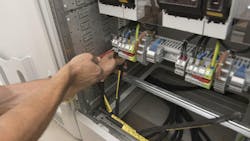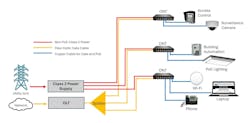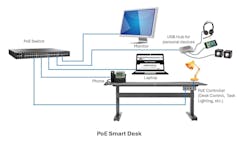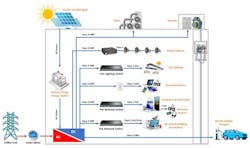Designing Smarter Buildings with Class 2 and Class 4 Power Systems
Many smart building operators optimize power delivery efficiency by deploying direct current (DC) infrastructure alongside alternating current (AC) systems. While AC remains ideal for long-distance transmission, it often requires local conversion to DC and additional hardware to safely power most modern electronic devices.
By shifting more in-building distribution to DC, operators reduce conversion losses, improve efficiency, and streamline integration with renewable energy sources and energy storage systems. Class 2, which includes Power over Ethernet (PoE), and the newer Class 4 Fault Managed Power (FMP), are DC-based delivery models with distinct electrical characteristics and safety mechanisms that meet specific application requirements.
This article outlines the technical distinctions between Class 2 and Class 4 power, highlights where each is most applicable, and explains how these technologies complement each other to support smarter, safer, and more energy-efficient building infrastructure.
Exploring Class-Rated Power Systems
The U.S. National Electrical Code (NEC) governs the design and installation of electrical distribution systems. Establishing safe wiring methods for both AC and DC, NEC also defines requirements for power-limited circuits, including Class 1, Class 2, and Class 3 systems. Designed to minimize fire and shock hazards by limiting voltage and power, these electrical distribution systems span:
- Class 1: Covers power circuits limited to 30 volts and 1,000 volt-amperes (VA), as well as remote control and signaling circuits limited to 600 volts. These systems are typically used in industrial control, remote device management, and signaling applications.
- Class 2: Limits circuits to 60 volts and 100 VA (or 100 watts for DC). These circuits are considered inherently safe from fire initiation and provide acceptable protection against electric shock. Class 2 includes PoE and is commonly used to power devices such as thermostats, security systems, IP phones, wireless access points (APs), and surveillance cameras.
- Class 3: Allows up to 100 volts and 100 VA. While these circuits offer fire protection comparable to Class 2, they provide less shock protection and require additional overcurrent safeguards. Common applications include audio systems, signaling devices, fire alarms, and nurse call systems.
- Class 4: Supports power delivery up to 450 volts and relies on active fault management—rather than power limitation—for safety, using specialized transmitters and receivers that continuously monitor for faults and limit fault energy. These FMP systems maintain the same level of fire and shock protection as Class 2 while enabling higher power delivery over longer distances. Applications include smart buildings, hotels, connected agriculture, smart poles, and other IoT use cases.
Class 2 Power: Safe, Scalable, and Widely Deployed
Class 2 circuit parameters effectively reduce fire and electric shock risk across a broad range of in-building applications. In many scenarios, Class 2 power circuits can be installed without conduit or a licensed electrician.
There are two primary approaches to implementing Class 2 power in smart buildings: PoE and direct DC power delivery. Defined by IEEE 802.3 standards, PoE transmits both data and DC power over twisted-pair Ethernet cabling, eliminating the need for separate AC circuits. As shown in Figure 1, PoE supports a broad range of devices, including IP phones, Wi-Fi access points, security cameras, smart lighting, and window shades.
PoE is typically delivered over two or four pairs of Category 5e, 6, or 6A cables, and can also operate over a single pair (SPoE) for low-speed automation systems.
PoE offers several key advantages, such as simplified installation, centralized power control, and operational flexibility. Devices can be located wherever network access is available, regardless of AC outlet placement, and can be centrally monitored, reset, or disabled via software. PoE systems also improve energy efficiency by reducing conversion losses and support seamless integration with smart building platforms.
Extending Class 2 Power: PoE Standards and Direct DC Delivery
The IEEE 802.3af, 802.3at, and 802.3bt standards define increasing levels of power delivery for PoE. Type 1 (af) delivers up to 15.4 W, Type 2 (at) up to 30 W, and Types 3 and 4 (bt) support 60 W to 90 W over four-pair Ethernet cabling. For single-pair Ethernet, IEEE 802.3cg enables SPoE to deliver up to 52 W over a single conductor pair, depending on voltage, wire gauge, and cable length. These capabilities extend PoE’s reach for low-power devices across large facilities—up to 1,000 meters under ideal conditions.
Class 2 power can also be delivered directly over copper conductors using centralized power supply units (PSUs) for devices that don’t require a data connection. These non-PoE systems typically use 16 to 20 AWG wire and are often installed alongside fiber in hybrid copper-fiber cables. This configuration is especially useful in passive optical LANs, where copper provides power while fiber transmits data to remote optical network terminals (ONTs) that distribute PoE locally.
Class 2 in Action: Popular Applications and Growing Adoption
Class 2 power supports many smart building applications. As shown in Figure 2, sit-stand desks can be powered entirely via PoE, including motors, monitors, USB charging hubs, and integrated air vents. PoE is also used for long-distance security cameras.
PoE lighting systems combine energy efficiency with centralized control and automation, often integrating occupancy, daylight, and environmental sensors to optimize both lighting and HVAC performance. These systems support daisy chaining of fixtures and centralized management via PoE nodes or gateways.
Driven by its cost efficiency, safety, and flexibility, Class 2 power is now an integral part of modern smart building infrastructure. Market forecasts project sustained growth, with the PoE market expected to expand from $1.4 billion in 2023 to nearly $9 billion by 2032.
Class 4 Power: Fault Management for High-Capacity DC Distribution
Also known as FMP, Class 4 power systems represent an emerging category of safe, high-capacity DC power distribution. Codified in Article 726 of the 2023 NEC, these systems are designed to address the power and distance limitations of Class 2 circuits while maintaining an equivalent—or even higher—level of safety. Rather than limiting voltage or power at the source, Class 4 systems restrict the energy delivered into a fault by continuously monitoring circuit integrity in real time.
A typical Class 4 system consists of a transmitter, receiver, and cabling certified under UL 1400-1 and UL 1400-2 standards. The transmitter converts input power—either AC from the grid or DC from sources such as solar panels or battery storage—and communicates with the receiver to verify circuit safety. If a fault is detected, the system shuts off power within milliseconds. Some implementations incorporate digital power packets that validate safety conditions before delivery, further minimizing the risk of fire or electric shock.
Expanding Reach: Class 4 Power for Long-Distance, High-Capacity Loads
Unlike Class 2 systems, which are limited to 60 volts and 100 watts, Class 4 circuits can deliver up to 450 volts and significantly more power over longer distances. For example, current FMP configurations can deliver 600 watts over 1,500 meters using multiple 18 American Wire Gauge (AWG) conductor pairs. This expanded capacity positions FMP as a practical alternative to traditional AC wiring for many building systems, particularly because it doesn’t require conduit or licensed electricians in most deployments.
FMP systems are especially effective for powering distributed infrastructure such as network terminals, lighting controllers, and switches. Operating alongside—rather than replacing—Class 2 technologies like PoE, FMP systems support centralized DC power distribution that extends reach and simplifies deployment. This complementary approach reduces the need for localized AC-DC conversion, minimizing energy losses and lowering operating costs. When implemented with hybrid copper-fiber cabling, FMP systems can deliver both power and data through a single cable pull, streamlining installation in both new construction and retrofits.
Class 4 in Practice: Diverse Deployments and Smarter Energy Control
FMP systems are deployed in stadiums, outdoor venues, warehouses, and high-rise buildings where long cable runs are required. They are also installed in controlled agriculture facilities to power high-capacity LED grow lights, and in smart hotels such as Hotel Marcel, which combined FMP with a DC microgrid to achieve net-zero operation. As shown in Figure 4, additional applications span digital signage, remote kiosks, security systems, audiovisual equipment, USB charging hubs, and EV charging infrastructure. Moreover, some data centers are evaluating Class 4 systems for direct DC power delivery to servers.
In addition to extending reach and power capacity, FMP systems enable advanced energy monitoring and load control. Facility managers can remotely manage devices, cycle power, and optimize consumption at a granular level. This capability supports smart building objectives, demand response programs, and tenant sub-metering without additional hardware.
Conclusion
Smart building operators must efficiently and cost-effectively support an increasingly wide range of sensor-driven, power-intensive infrastructure. With its proven safety profile and broad adoption, Class 2 power remains a popular choice for low-power applications that require both power and data delivery, such as PoE-enabled systems.
In parallel, Class 4 FMP offers a complementary approach, facilitating higher power levels and longer distances while maintaining comparable or greater safety protections. Together, these delivery models enable flexible, scalable power architecture that supports diverse use cases, from lighting and security systems to network infrastructure and intelligent building automation.
About the Author
Marta Soncodi
Marta Soncodi is the Smart Buildings Program Director at the Telecommunications Management Association (TIA), developing assessment criteria and services for Smart Buildings. She has over 30 years of ICT industry experience as a software engineering manager and program manager responsible for global telecom projects development, business process automation solutions, and new technology investigation and prototyping. At TIA, Marta has previously managed standards committees and the Edge Data Centers program and has investigated a large variety of Smart Buildings technologies, standards and protocols on topics like in-building connectivity, IoT, energy harvesting, LoRaWAN, and LiFi. Marta holds MSc in Computer Science and MBA in telecom degrees and is a certified PMI PMP project manager.




